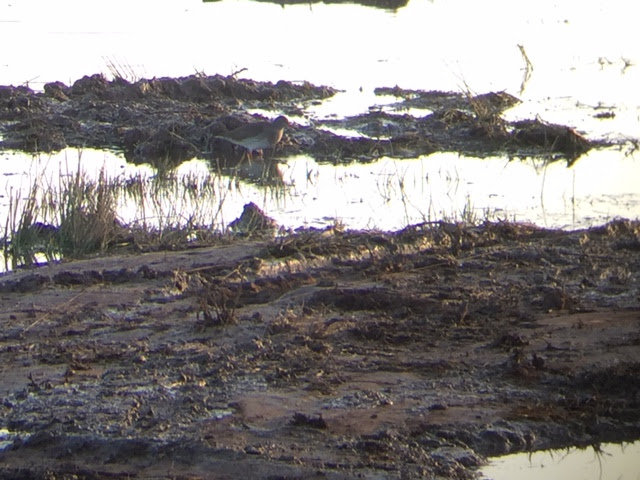79. Collared dove subsequently picked up
80. Little owl appeared on Hallytreeholme Farm in more clement weather
81. Red kite pottered over the car park on the 10th
82. The red head smew reappeared at Watton NR on the 11th
83. Along with the long tailed duck back on its familiar haunt in front of the new hide (still there today). Both these birds are thought to feed on the river and come back to the reservoirs to roost or refuge - much like the velvet scoter this time last year.
84. Goosander on the 12th
But it perhaps the gull roost on the D reservoir which has finally come good. After a slow start this autumn things have finally come picked up and the northerly gales, storm surges, thundersnows etc, have at least pushed us in some specialities:
85. Roy Erich and Martin picked up this glaucous gull on the 5th (write up on Erich's page here) - Photo Martin Lonsdale:
Another glaucous gull arrived on the 12th picked up by Martin Hodges. But in between on the 8th had been caspian gull as filmed by Martin Hodges - no doubt video to feature on his blog shortly.
A cetti's warbler was calling on the 12th and the first shelduck has arrived back on the D reservoir taking us to 88 species so far.
From the 1st of January Roy Lyon has provided some pictures of the corn bunting flock at Easingwold which has been seen again since - 5 birds:
Along with the healthy numbers of reed buntings
And the WTW song thrush
But breaching from beneath the ice have been the main attraction for the last couple of weeks - Francis Bell:
No longer are field signs like a few fish scales the only way to find them:North Marsh has been giving great views of otters for the likes of Steve Brimble:
Darren Smith:
And further pictures on Africa Gomez's page here. Indeed they are so regular we suggest a real coup would be to try and photo the near ermine stoat running over the ice there this morning.
Hopefully the otters will appreciate our final finishing flurries - we've done some more sealing of the new reception hide pond to bring the level up to its full potential:
And with this successfully completed, as ever with the help of the volunteers, we've tweaked a few other bits - namely the dyke at the back of the pond (A kind of mini north marsh for folk to enjoy on the new walk):
The little ringed plover island in front of South Marsh hide had been lost to vegetation and was too high when built 3 years ago. This has been graded out with more wader edges for close in pictures:
Already attracting the attentions of redshank within the day:
A subtle but important tweak to the bog oak in 'sandpiper bay'; Its been shunted up a bit so is now in clear view - as it was a favourite perch for kingfishers and sandpipers last year but just obscured behind the brow - now its perfectly aligned for cameras along with some more bog oak to compliment:

There are a few tweaks for Hempholme hide too for better photo ops to be finished shortly. Lots of fine tuning which has been happily ticked off so we don't have to return with a digger in the near future anywhere. One of the most crucial has been the clearance of a channel to north lagoon from the inlet sluice. The complexities of lagoon management are enormous so really these pictures are for former Warden Peter Izzard whom can fully appreciate the beauty of a silt covered sluice...
Suffice to say it should improve both the wildlife and the operational capability of the lagoons going forward. A great feat too given the 5t digger was working where I immediately sank to my thighs:
Finally as part of the on-going reception hide project we have a post going for a self employed Education Guide. We have run school visits for many years to the reserve but with myself as guide rather than a dedicated 'educator.'
Yorkshire Water have a number of educational centres across the region and with the new improved facilities we intend to at last offer a key stage planned visit to reserve with a dedicated Education Guide. It'll be a capped number of one day a week in term time (24 days a year) so should have little impact on the reserve and visitors, whilst offering water and environmentally themed education to local schools. Closing date is the 20th January.
For full details please visit the Yorkshire Water careers page here. For any questions about the role please contact anne.reed@yorkshirewater.co.uk.






















